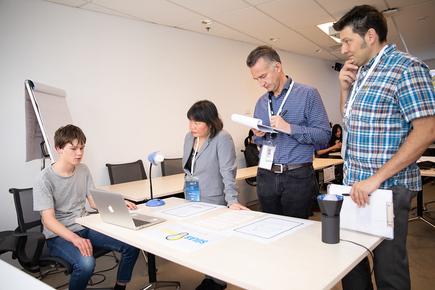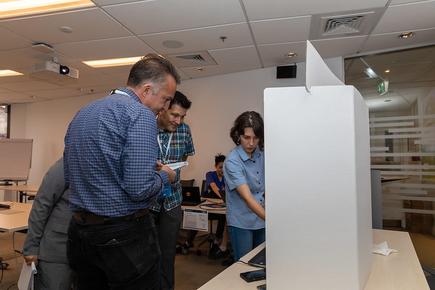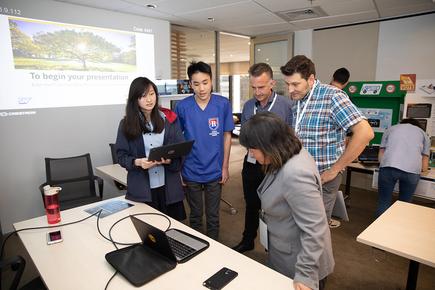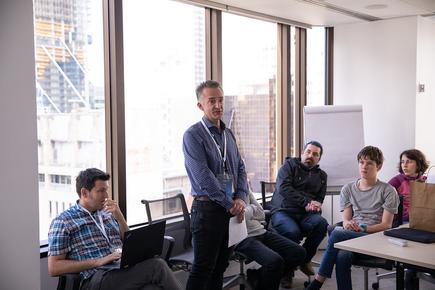From solving ‘real world problems’ to ‘passion projects’ - how to get more young people involved in ICT
- 08 October, 2019 10:00

Jasmine Jared received the top prize for iLearn, and will compete with the Australian students at the YICTE awards in Sydney in December.
All types of projects are welcome provided they have a clear link to technology. Students have complete control of their ideas, enabling them to design projects they want to see brought to life
“The scope of the Young ICT Explorers (YICTE) competition is kept broad to encourage as much creativity as possible, as well as to encourage greater participation,” says Pete Andrew, chief operating officer at SAP ANZ.
“Because students are given freedom to choose their project and are not limited to specific problems to solve or technology to use, we not only see some really brilliant ideas, but we also see high rates of female participation,” he expounds.
“We are now at 50 per cent female student participation across the whole competition in New Zealand and Australia, which is fantastic,” he says, as he highlights how YICTE differs from similar initiatives to encourage young students to get into ICT.
“We are seeing this approach work, as we receive increasing interest in Young ICT Explorers year-on-year,” Andrew adds.
SAP’s YICTE is a non-profit competition and is open to students from Year 3 to 13.
The programme, now in its 10th year in Australia and fourth year in New Zealand, was designed to give students the “highest degree of freedom possible”, explains Travis Joy, YICTE programme director.
 Credit: SAP NZ
Credit: SAP NZ“Students can work on their projects for as long as they like, with YICTE being their meeting point to showcase the ideas once a year,” notes Joy.
He says students can create projects in the classroom “that solve real world problems, ” or as an extracurricular activity, for “passion projects of their own choosing”.
“Our goal is to inspire school students to use their creativity and innovation skills to gain a greater understanding of the diverse possibilities available to them through today’s technology, encouraging students to consider future study and a career in technology,” he adds.
 Credit: SAP NZ
Credit: SAP NZWe are now at 50 per cent female student participation across the whole competition in New Zealand and Australia, which is fantastic
“All types of projects are welcome provided they have a clear link to technology. Students have complete control of their ideas, enabling them to design projects they want to see brought to life.”
The New Zealand event was held over a week ago, with CIO New Zealand joining the judges from SAP - Angus Keer-Keer, practice manager - global consulting delivery; and Matthias Braun, development expert.
Students were given five minutes to present their projects to the judges, who were then given another five minutes to query the students.
 Credit: SAP NZ
Credit: SAP NZEach project was assessed on the criteria of creativity and innovation, quality and completeness, level of difficulty, and project documentation.
The New Zealand entries this year were all Year 9 to 10 students from Rangitoto College.
 Credit: SAP NZ
Credit: SAP NZThe top prize went to Jasmine Jared for iLearn, and she will join the Australian students for the top prize at the YICTE awards in Sydney in December.
iLearn is an artificial intelligence (AI) app to learn foreign languages.
She explains how it works: “Imagine during your walk you see people playing basketball and you want to know how to describe what you see in Chinese as it is a step towards learning the language. The answer is simple: start ILearn, take a picture of the scene with your device's camera, and the application will describe what is on the picture in your chosen language/s (Chinese, English, Japanese, Spanish, and Portuguese).
 Credit: SAP NZ
Credit: SAP NZ“In our case with the basketball game, the app could say something like: ‘People playing basketball‘ in English and Chinese. It could also help some people in their understanding of their native language.”
 Credit: SAP NZ
Credit: SAP NZThe second prize went to Lana Zhang and Tyler Young for ‘Claritas – Progress made simple’.
Claritas is an online platform that allows students to view their own academic history and create goals from their successes and mistakes, while also being notified of any upcoming events or assignments of the student.
The platform will feature the student’s own unique academic radar chart, reflecting progress in academic studies, tools to help students create their own goals, view and encourage class peers’ academic progress and various other features to make Claritas an essential for a student.
 Credit: SAP NZ
Credit: SAP NZAs they told the judges, this product will be targeted at secondary school students and would be available to those with an email account. Students will be able to enter manually enter in their assignments’ results per subject into Claritas termly and will be able to have a clear visual of their learning journey.
“With Claritas, we hope to encourage self-growth, punctuality, preparation, and goal setting in our young people,” they state.
 Credit: SAP NZ
Credit: SAP NZThe third prize went to Jessica Wang for Type it.
“My project is a fun and engaging way for people to learn to type faster,” says Wang. “It has the form of a game so that learning while using it will be less boring.”
 Credit: SAP NZ
Credit: SAP NZThe Metimurbel team - Anna Haine, Lucas Hebberd, Hannah Clausen, Julia Lim - got a merit award.
 Credit: SAP NZ
Credit: SAP NZThey explain: “Our project is designed to test the decibel levels in rooms where music or other loud sounds are being played to indicate when noise is at a level where it will start causing permanent hearing damage. We hope to achieve a project that does this while working in a small space so it can fit on a wall.”
 Credit: SAP NZ
Credit: SAP NZYICTE participants are also invited to refine their projects further and enter again the following year.
Angus Keer-Keer, who handed the prizes to the winners, reminds all the participants: “We see a great future to evolve this together...we want you to come back next year.”
 Credit: SAP NZ
Credit: SAP NZSign up for CIO newsletters for regular updates on CIO news, career tips, views and events. Follow CIO New Zealand on Twitter:@cio_nz
Send news tips and comments to divina_paredes@idg.co.nz @divinap

